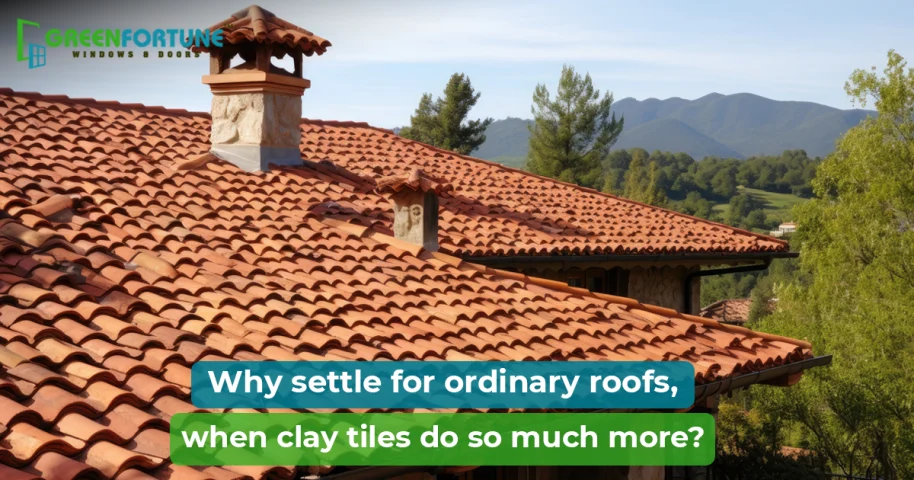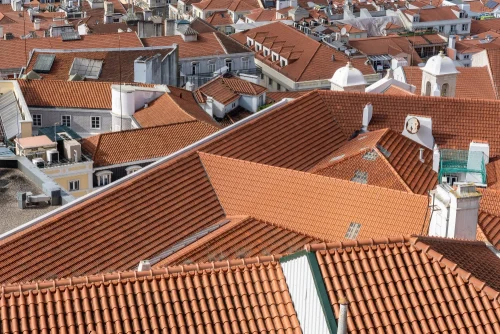
9 Best AI Interior Design Apps for Designers in India
August 13, 2025
Stunning Home Library Design Ideas for Modern Homes
August 13, 2025Clay tile roof benefits are often overlooked in today’s age of glossy, synthetic, and high-tech roofing materials. With options that promise waterproofing, solar reflection, and ultra-modern finishes, clay tiles are often assumed as outdated. But the twist is that this classic roofing style delivers all benefits of roofing such as strength, heat resistance, and serious longevity.
In fact, when you compare them against newer materials, especially for the best roofing for hot climates, clay tiles continue to lead with its benefits.
This blog will cover what clay roof tiles are, how they’re made, and the key benefits they offer for long-term durability, comfort, and curb appeal.
Table of contents
- What Are Clay Tiles?
- How Is a Clay Tile Roof Made?
- 1. Helps Lower Indoor Temperature
- 2. Easy to Replace Without Disrupting the Whole Roof
- 3. Fire and Pest Resistance
- 4. Requires Minimal Maintenance Over Time
- 5. Environmentally Friendly and Sustainable
- 6. Retains Its Color Over Time
- 7. Strong Performance in High Winds
- Ready to Explore Clay Tile Roofing?
- FAQs
What Are Clay Tiles?
Clay tiles are roofing materials made from natural clay that is shaped and then fired at high temperatures. The process hardens the clay into strong, weather-resistant tiles that can withstand heat, rain, and wind. They usually have a curved or flat shape and are available in natural colors like terracotta, red, or brown. These are commonly referred to as terracotta roof tiles and used for roofing in hot or dry climates because they reflect heat and last for decades.
How Is a Clay Tile Roof Made?
A clay tile roof is built by laying individual clay tiles in overlapping rows on top of a waterproof underlayment. First, the roof deck is covered with a protective layer to block moisture. Then, clay tiles are nailed or hooked onto battens or directly to the deck, depending on the design.
Let’s break down 7 standout clay tile roof benefits that prove why this roof style still dominates the modern construction.
1. Helps Lower Indoor Temperature
Clay tiles are a top choice for thermal performance as their natural composition and curved design allow for better air circulation beneath the tiles. It creates a thermal barrier that reduces heat transfer into your home.
This is one of the biggest clay tile roof benefits: they reflect sunlight instead of absorbing it, which helps lower indoor temperatures. This natural cooling effect helps reduce air conditioning usage, which leads to lower energy bills and makes them one of the best roofing options for hot climates.
Best for: Homeowners living in hot or sunny climates who need to minimize energy consumption and avoid heat buildup indoors.
2. Easy to Replace Without Disrupting the Whole Roof
Each clay tile is installed individually, not in large connected sheets. If a tile breaks or gets damaged, you can remove and replace just that one tile. You won’t need to pull apart a big section of your roof.
This means faster, less expensive repairs and fewer maintenance over the years. Minor issues stay minor, and there’s no need to redo entire areas for a single crack.
Best for: Homeowners looking for long-term convenience and affordable maintenance.
3. Fire and Pest Resistance
Clay tiles are fire-resistant because they’re made from non-combustible materials. Unlike wood or synthetic shingles, they won’t catch fire, melt, or warp under high temperatures. This makes them especially useful in areas prone to wildfires. They also resist termites and other pests. Clay doesn’t rot, so you won’t have to deal with mold or insect damage that can ruin wood-based roofing.
Best for: Homes in wildfire-prone regions or areas where termite control is a concern.
4. Requires Minimal Maintenance Over Time
Once properly installed, clay tile roofs need very little upkeep. They don’t require sealing, frequent cleaning, or chemical treatments. Clay naturally resists mildew, algae, and mold buildup, which saves homeowners both time and long-term maintenance costs. You won’t need to schedule constant inspections or treatments just to keep the roof intact. Some clay tile roofs are even 50 to 100 years old and still in excellent condition. Since these tiles don’t retain water, waterproofing chemicals for terraces also tend to last longer.
Best for: People who want a reliable, long-lasting roof without ongoing effort.
5. Environmentally Friendly and Sustainable
Clay tiles are made from natural materials like clay and water, without chemical processing. That means lower emissions during manufacturing and fewer toxins released into the air.
Even at the end of their (very long) lifespan, the tiles can be crushed and recycled instead of ending up in a landfill. Since replacements are rarely needed, it also reduces the frequency and cost of recycling. Their full lifecycle, from production to disposal, remains sustainable, which makes them one of the most trusted eco-friendly roofing materials available today.
Best for: Eco-conscious homeowners looking to reduce their footprint with natural, long-lasting building materials.
6. Retains Its Color Over Time
Clay tiles are baked at high temperatures during manufacturing, which locks in their color. This process ensures the color won’t peel, fade, or chip—even after years of exposure to harsh weather. This durability is often missing in painted metal or asphalt shingles, which tend to lose their finish over time.
Even after years under the sun, your roof will continue to look clean and attractive with almost no maintenance.
Best for: Homeowners who don’t live in the house full-time, like rental properties or second homes, and need a low-maintenance solution.
7. Strong Performance in High Winds
Clay tiles are heavier than most roofing materials like asphalt shingles or metal sheets, and they’re installed using interlocking systems that anchor them firmly in place. This makes them highly resistant to strong winds, including those from hurricanes and major storms.
When installed correctly, clay roofs are far less likely to suffer wind-related damage compared to lighter materials.
Best for: Homes in coastal or windy regions where storms and high winds are a regular concern.
Ready to Explore Clay Tile Roofing?
Whether you're aiming for aesthetics, performance, or peace of mind, clay tiles deliver all three. As one of the most durable and eco-friendly roofing materials, clay or terracotta roof tiles deliver long-term benefits without compromising on performance or aesthetics.
If you wish to have clay roof tiles benefits, similar benefits can be derived using uPVC doors and windows, profiles from GreenFortune.
FAQs
Q1. Is a clay tile roof too heavy for a regular home structure?
Clay tiles are heavier than asphalt or metal, but most modern homes can handle the weight with proper underlayment. A structural assessment is recommended before installation.
Q2. Are clay tiles only suitable for traditional-style homes?
This is not true. Clay tiles now come in various styles and colors, from Mediterranean curves to flat contemporary profiles, so they can suit modern designs too.
Q3. Can clay tiles handle heavy rain or snow?
Yes, with proper installation and pitch, clay tiles can manage rain runoff effectively. In snowy areas, some extra structural support and snow guards may be needed, but the tiles themselves are not a problem.
clay tile roof benefits for Indian Homes





